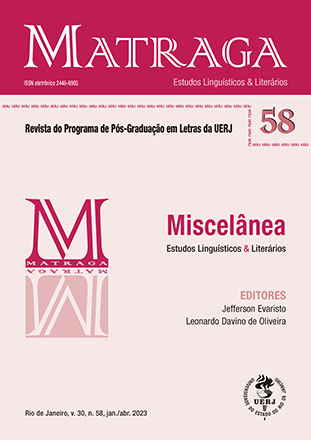Mediado pelo canto da musa e da sereia: a travessia poética de Ariano Suassuna
DOI:
https://doi.org/10.12957/matraga.2023.68723Palavras-chave:
Musa, Sereia, Poesia, Revocalização, Ariano Suassuna.Resumo
O presente artigo objetiva alocar o canto suassuniano como uma produção artística mediada pelo canto da musa e o canto da sereia, partindo de uma (re)leitura dessas duas vozes. No fazer poético/literário de Ariano Suassuna é nítida a construção mítica do sertão nordestino e o diálogo proposto pelo autor entre artes eru- ditas e artes populares. Tendo como base esse modo singular de confecção literária, busca-se compreender este canto poético em três poemas que compõem o CD intitulado A poesia viva de Ariano Suassuna. Para tan- to, este estudo será embasado em alguns teóricos que discutem o papel das musas e das sereias no mundo contemporâneo, como Maurice Blanchot (2005), Jacyntho Brandão (2000) e Adriana Cavarero (2011), viabili- zando uma abordagem teórica desses seres na atualidade; Eduardo Sterzi (2012) e Eric Havelock (1996), para pensar o lugar da voz da musa no poema contemporâneo; Hildebrando Barbosa (2018), Ester Simões (2016) e Silviano Santiago (2007), para compreender as poesias de Suassuna. Dessa forma, os poemas de Suassuna são analisados dentro desta nova ótica atribuída às musas e às sereias.
Downloads
Downloads
Publicado
Como Citar
Edição
Seção
Licença
AUTORIZAÇÃO
A Matraga – Revista do Programa de Pós-Graduação em Letras da UERJ está autorizada a publicar o artigo ora submetido, caso seja aceito para publicação online. Fica atestado que a contribuição é original, que não está sendo submetida a outro editor para publicação, e que a presente declaração é a expressão da verdade.
Os trabalhos publicados no espaço virtual da Matraga – Revista do Programa de Pós-Graduação em Letras da UERJ serão automaticamente cedidos, ficando os seus direitos autorais reservados à Matraga. Sua reprodução, total ou parcial, é condicionada à citação dos autores e dos dados da publicação.

A Matraga utiliza uma Licença Creative Commons - Atribuição-NãoComercial 4.0 Internacional.





